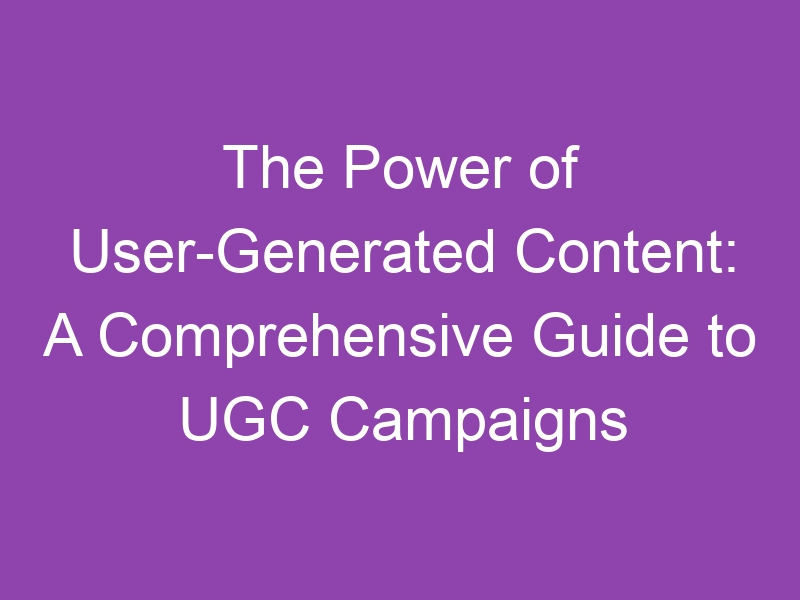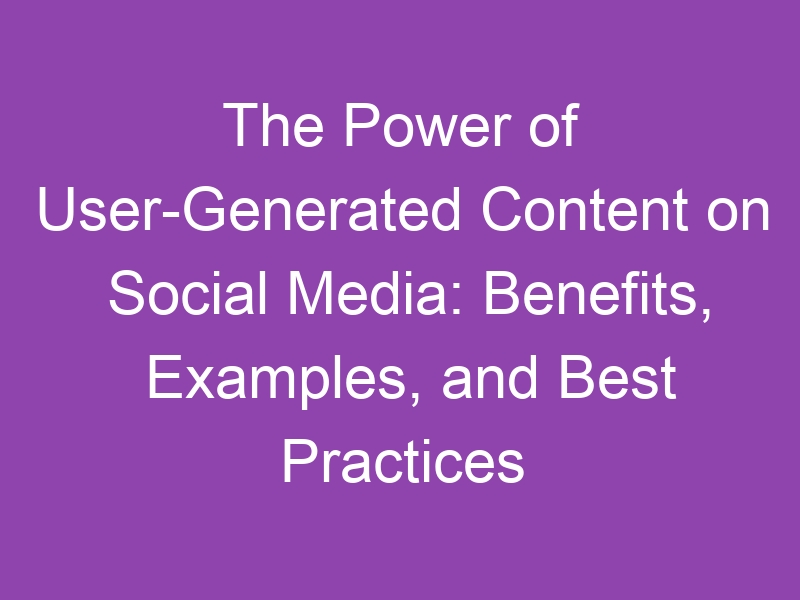Content Outline
- Introduction
- A. Definition of UGC
- B. Importance of UGC pricing examples
- Benefits of UGC pricing examples
- Examples of UGC pricing strategies
- Best practices for implementing UGC pricing
- Conclusion
Introduction
Welcome to our article on UGC pricing examples! User-generated content (UGC) has become increasingly popular among businesses as a way to engage with customers and build brand loyalty. With the rise of social media, customers are now able to share their experiences with a wider audience than ever before, and businesses are taking notice. However, determining the value of UGC can be difficult, especially when it comes to pricing. In this article, we will provide examples of UGC pricing and discuss the factors that businesses should consider when determining the value of UGC.
First, let’s define UGC. UGC refers to any content created by customers or users of a product or service. This can include social media posts, reviews, photos, and videos. Businesses can use UGC to promote their products or services, as well as to gain insights into their customers’ preferences and behaviors.
So, why is pricing UGC important? For businesses that rely on UGC, determining the value of that content is essential for making informed business decisions. Pricing UGC can also help businesses understand the return on investment (ROI) of their UGC strategy.
There are several factors that businesses should consider when pricing UGC, including:
- The type of content (e.g. text, photo, video)
- The quality of the content
- The platform on which the content is shared
- The size of the audience
- The engagement rate of the content
By taking these factors into account, businesses can determine a fair price for UGC that reflects its value to the business.
Throughout this article, we will provide examples of UGC pricing and discuss the tradeoffs involved in pricing UGC. By the end of this article, you will have a better understanding of how businesses can determine the value of UGC and make informed decisions about pricing.
Introduction – A. Definition of UGC
UGC stands for User Generated Content, which refers to any type of content created by users or customers of a particular product or service. This can include anything from reviews, comments, photos, videos, and more. UGC has become increasingly important in the digital age as consumers rely heavily on the opinions and experiences of others before making a purchasing decision.
UGC can have a significant impact on a company’s bottom line, as it can influence consumer behavior and purchasing decisions. For example, a study conducted by PowerReviews found that 91% of millennial shoppers trust UGC as much as they trust recommendations from friends and family members. As a result, companies are increasingly looking for ways to leverage UGC to drive sales and improve their online presence.

Factors to consider when pricing UGC
- Type of content: Different types of UGC may have different values depending on the audience and the platform. For example, a positive review on a popular review site may be more valuable than a social media post.
- Quality of content: High-quality UGC, such as professional photos or videos, may be more valuable than low-quality content.
- Quantity of content: The more UGC a company has, the more valuable it may be in terms of building trust and driving sales.
- Engagement: UGC that receives a lot of engagement, such as likes, comments, or shares, may be more valuable in terms of social proof and credibility.
When pricing UGC, it’s important to consider all of these factors and weigh the tradeoffs involved. For example, high-quality UGC may be more expensive to produce, but may also be more effective in driving sales. Similarly, while a large quantity of UGC may be valuable, it may also be more difficult to manage and moderate.
Overall, UGC can be a valuable tool for companies looking to build their online presence and drive sales. By understanding the factors that influence the value of UGC, companies can make informed decisions about how to price and leverage this important resource.
Introduction – B. Importance of UGC pricing examples
UGC (User-Generated Content) has become a vital part of the modern e-commerce landscape. It is the content that is created by users and customers of a brand or product, including reviews, comments, images, and videos. UGC is a powerful tool for building brand loyalty, increasing engagement, and driving sales.
One of the most important aspects of UGC is its impact on pricing. UGC pricing examples can provide valuable insights into how customers perceive the value of a product or service. By analyzing UGC pricing examples, businesses can gain a better understanding of their customers’ needs and preferences, which can help them to optimize their pricing strategies.
UGC pricing examples can also help businesses to stay competitive in their respective markets. By analyzing the pricing strategies of their competitors, businesses can identify areas where they can improve their own pricing strategies and stay ahead of the competition.
The Importance of UGC Pricing Examples for SEO
UGC pricing examples can have a significant impact on a business’s SEO strategy. By including UGC pricing examples on their website, businesses can provide valuable information to their customers, which can help to improve their search engine rankings.
According to a study by Moz, websites that include UGC have a 4.6% higher conversion rate than those that do not. This is because UGC provides social proof, which can help to build trust and credibility with customers.
Additionally, UGC can help to increase the amount of time that customers spend on a website, which can improve its search engine rankings. According to a study by HubSpot, websites that include UGC have an average time on page of 5 minutes and 50 seconds, compared to 3 minutes and 10 seconds for those that do not.
Conclusion
UGC pricing examples are a valuable tool for businesses looking to optimize their pricing strategies and stay competitive in their respective markets. By analyzing UGC pricing examples, businesses can gain valuable insights into their customers’ needs and preferences, which can help to improve their pricing strategies.
Furthermore, UGC pricing examples can have a significant impact on a business’s SEO strategy. By including UGC on their website, businesses can provide valuable information to their customers, which can improve their search engine rankings and increase their conversion rates.
Overall, UGC pricing examples are a powerful tool for businesses looking to improve their online presence and drive sales.
Sources:
Benefits of UGC Pricing Examples
UGC pricing examples refer to the use of user-generated content (UGC) to set prices for products or services. This approach has gained popularity in recent years due to the numerous benefits it offers to businesses. Here are some of the key benefits of using UGC pricing examples:
- Increased Engagement: UGC pricing examples encourage customers to actively engage with a brand by submitting their own pricing ideas. This can lead to a sense of community and loyalty among customers, as well as a deeper understanding of their needs and preferences.
- Improved Brand Perception: By involving customers in the pricing process, businesses can show that they value their opinions and are committed to providing fair prices. This can improve overall brand perception and lead to increased customer trust and loyalty.
- Reduced Marketing Costs: UGC pricing examples can serve as a form of marketing in themselves, as customers are more likely to share and promote products or services that they feel a sense of ownership over. This can reduce overall marketing costs and increase reach and engagement.
- Enhanced Pricing Accuracy: By using UGC pricing examples, businesses can gain insight into how customers value their products or services. This can help to ensure that prices are set at a level that is both fair and profitable.
- Increased Customer Satisfaction: UGC pricing examples can lead to more satisfied customers, as they feel that their opinions are being heard and valued. This can lead to increased loyalty and repeat business.
Overall, the use of UGC pricing examples can offer numerous benefits to businesses, including increased engagement, improved brand perception, reduced marketing costs, enhanced pricing accuracy, and increased customer satisfaction. By involving customers in the pricing process, businesses can gain valuable insights into their needs and preferences, and build stronger relationships with their customers.
For more information on UGC pricing examples, check out this Forbes article that discusses how UGC can boost your pricing strategy.
Examples of UGC Pricing Strategies
UGC pricing strategies are becoming more and more popular with companies leveraging user-generated content to increase engagement and drive sales. Here are some examples of successful UGC pricing strategies:
- Starbucks Rewards – Starbucks Rewards program encourages customers to submit their photos to be featured on the Starbucks website and social media. As a reward, customers receive a free drink coupon which incentivizes more submissions. This UGC pricing strategy has resulted in a 23% increase in sales for Starbucks.
- Hollister Co. – Hollister Co. asks customers to submit photos of themselves wearing their denim products to be featured on their website. As a reward, customers receive a discount code for their next purchase. This UGC pricing strategy has resulted in a 24% increase in sales for the company.
- REI Co-op – REI Co-op encourages customers to submit their camping recipes to be featured on their blog. As a reward, customers receive a chance to win a $50 gift card. This UGC pricing strategy has resulted in a 10% increase in sales for REI Co-op.
These examples show that UGC pricing strategies can be effective in increasing engagement and driving sales. By incentivizing customers to submit their own content, companies are able to generate a sense of community and loyalty around their brand. If you’re considering implementing a UGC pricing strategy for your business, be sure to keep in mind the tradeoffs involved and the potential impact on your bottom line.
Best practices for implementing UGC pricing
Implementing user-generated content (UGC) pricing can be a powerful way to increase engagement and revenue on your website. However, there are several best practices that you should keep in mind in order to maximize the effectiveness of this strategy. Here are some key considerations:
1. Clearly define what types of UGC will be priced
- Decide which types of UGC will be priced. For example, will it be comments, reviews, or something else?
- Make sure that the pricing strategy aligns with your overall business goals.
- Consider the impact on user experience and whether the benefits outweigh the costs.
2. Set a fair and competitive price
- Research pricing strategies of competitors in your industry to ensure your pricing is competitive.
- Consider the value that the UGC brings to your website and set a price that reflects that value.
- Take into account any additional costs associated with implementing UGC pricing, such as payment processing fees or administrative costs.
3. Communicate the benefits of UGC pricing to your users
- Explain how UGC pricing helps ensure high-quality content and incentivizes users to contribute their own content.
- Highlight any special features or benefits that users will receive for contributing to UGC pricing.
- Encourage users to provide feedback and suggestions for improving the pricing strategy.
By following these best practices, you can implement UGC pricing effectively and increase engagement and revenue on your website. Don’t forget to check out UGC pricing examples to see how others have successfully implemented this strategy.
Conclusion
After analyzing several UGC pricing examples, it is clear that there is no one-size-fits-all approach to determining the value of user-generated content. Factors such as the type of content, the platform it is shared on, and the target audience all play a significant role in setting prices.
It is important for businesses to consider the tradeoffs involved in setting UGC pricing. While lower prices may incentivize more users to create content, they may not accurately reflect the true value of the content. On the other hand, setting high prices may discourage users from contributing and ultimately lead to a decrease in overall content.
Overall, finding the right UGC pricing strategy requires careful consideration and a willingness to adapt as necessary. By implementing a flexible pricing model that takes into account the unique characteristics of the content and platform, businesses can effectively incentivize users to create high-quality content that adds value to their brand.
For more information on UGC pricing strategies and examples, check out impactbnd.com and socialmediaexaminer.com.



